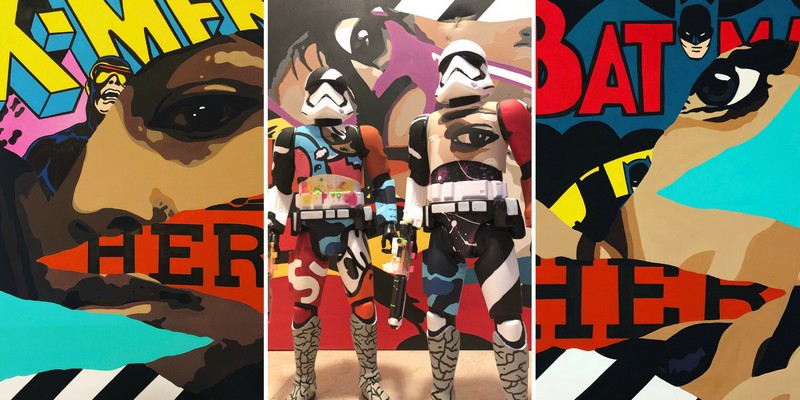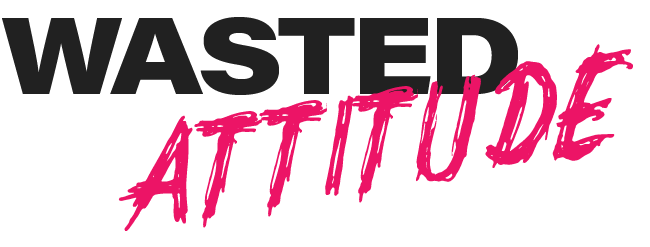Words: Miljan Milekić
Marlon Diggs is a 30-year old artist from Newport News, Virginia, currently located in the DC area. Specialized in pop art and street art, Diggs explores different influences touching on popular culture, referencing it, and accompanying it with strong messages. Lately, he’s expanding his work to some other interesting projects, so it was the right time for this interview.

So, first of all, tell us more about yourself and your beginnings? How did you get into art, and at what point did you decided that art is what you want to do in your life?
Marlon: I always loved drawing growing up. I was into comics, sneakers, and sports and would always draw those things in class or in my free time when I should have been doing other things. I had the skill but never had any real sense of direction or thought I could actually do something with my skill. It wasn’t until 2011 when I saw myself in this cycle of going in and out of jobs I didn’t care about or wasn’t happy with that I realized art is the only career I have a passion for and can see myself in long term. All the bullshit jobs and uninspiring surroundings kind of lit the fire under me.
You moved from Newport News in Virginia to Washington, DC area. Can you compare the places in terms of art scene and opportunities, and how did your life change after moving?
Marlon: The art scene is completely different in the 757 area I came from compared to the DC area. Back home the art scene is on the rise but I think I grew a little faster and needed a change of scenery. I would show my work at different cafes or pop up locations or events that I’m grateful for, but I knew I wanted more or could do more. I wanted a challenge or to be pushed in a way I wasn’t at home. I think DC is more appreciative of the arts and invests more into what’s right in their backyard and gives rising artists more chances. I have more access to art around me at any given time. In DC I’ve gotten bigger opportunities and more nationally known opportunities compared to before. Things have really picked up since I’ve moved. Before I left I had maybe 30 paintings laying around that I couldn’t move, where now I’m getting a lot more recognition. I don’t even have my own work on my wall now because I end up selling it.
Do you think that change influenced your art, and in what way?
Marlon: It’s definitely kept me focused and challenged me. I’m a lot more inspired by having such easy access to art at any time. Being around art more often and seeing other artists has made me tweak or brush up on my skills more, and I’m always looking for ways to improve. I study other artists and it pushes me to have a cleaner finish or crisper lines or just working on ways to continue to stand out being on a bigger stage.
Stylistically, your art is influenced by artists like Roy Lichtenstein and Kaws. How did you get in touch with pop art, and what motivated you to try it?
Marlon: Being a fan of comics and cartoons, it came naturally. I remember going on field trips or seeing books and slides in art class of Roy Lichtenstein and Andy Warhol and their work jumped out at me and being young it was all I could relate to or appreciate at the time. The bright colors and images I actually knew attracted me. I remember seeing Warhol’s Superman and Popeye or Lichtenstein’s ‘Whamm’ and being able to connect or tie that into the comics I read.
How much do you love The Simpsons?
Marlon: I love The Simpsons especially the first 2 seasons. I still have the marathons playing in the background as I work. The Simpsons are a big reason why I put a lot of subliminal messages and bold lines in my work. In art or anything in life, I would love to have the longevity that The Simpsons has had.

Besides pop art, and mentioned artists, it’s easy to see the influences of cartoons and comics in your works. Where do you take your inspiration from?
Marlon: A lot of my inspiration comes from everyday life, past experiences, and relationships. Relationships being the biggest one. I’m able to see something randomly walking through the city or just doing everyday tasks and that will remind me of an experience or person and I’m able to tie that into something completely different and I’ll run with that idea. An example would be Spiderman, you might see a superhero I see a way to pay tribute to someone from Queens that has impacted my life. Or the way I cut the Hermes logo to put emphasis on the “Her.” All of my work tells a story and has hidden messages that I put right in your face, it’s up to the viewer to find them. I enjoy hearing what others make out of my work or how it makes them feel.
From the first idea to the final painting, can you describe your work process?
Marlon: Everything starts with a story, feeling, or emotion. What am I trying to accomplish? Once I have that figured out I look for images or comic panels and patterns that I can use to tell/show that story or emotion. I then rip those images up and arrange them so that words are taken out of context and the images start to tell the story I want. I will often layer the images over someone’s (women’s) face only exposing noticeable facial features or the features I’m most attracted to. Once I get that final arrangement I’m happy with I then draw it out on canvas and start painting. Every painting has at least 3 other possible ideas I scrapped.
From Virginia to DC and France, you had your chance to present your work to various people in exhibitions. How did people react to your art, and did you have any comments you especially liked?
Marlon: The reception of my art has been great and I’m still getting used to it. It’s unreal at the time because I’m doing something I love and that has become second nature and people love it. I have conversations with people I wouldn’t think I have anything in common with or that I would ever talk to. My work has bridged age, race, and gender gaps and that’s kind of cool. A lot of the comments that stand out or that I enjoy are from women who appreciate work where I do honor other women because they are a big influence on both my art and life. Also comments I get from older art enthusiasts who may not have been a fan of my type of art but are now coming around to opening up to younger artists and their style.
What are your plans for the future? Can we expect to see you in some other art forms, maybe in comics or fashion?
Marlon: Yes, both comics and fashion are goals I’m perusing. A lot of my paintings are laid out like comic covers so I’m always envisioning that from the start. I currently have the pizza boxes in the DC and NY areas so different collaborations and partnerships are something I wish to expand on. I would love to move more into the design side of things, so I’ve been painting on various other items and playing with different concepts. My Creative Director Ms. Nics gave me this idea to paint on basketballs recently and it’s really been received well. So hopefully more doors will open and ill get more opportunities to show my range.
For the end – what do you want to accomplish with your art? Is it paying tribute to the things you love, or you have any other, bigger message you want to send?
Marlon: Short-term, the goal has always been using my art to open doors and see the world. Long-term, to continue to pay tribute, as well as send messages such as woman empowerment and the importance of minorities in art, comics and cartoons as well as giving a positive image of that, just to name a few. When it’s all said and done in the end, the same way I listed artists that influenced me I want to be that inspiration for the next generation especially to minorities. The same way Liechtenstein and Warhol influenced me, I think I can be one of the pop art influencers of color to someone younger or someone they can relate to.
Follow Marlon Diggs:
Website: https://www.marlymcfly.com
Instagram: https://www.instagram.com/marly_mcfly87


